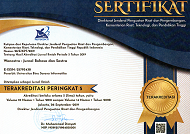Stereotypical Image of Chinese People in Hollywood’s The Karate Kid 2010 Movie
Abstract
Full Text:
PDFReferences
Addison, E. (1993). Saving Other Women from Other Men: Disneys Aladdin. Camera Obscura: Feminism, Culture, and Media Studies, 11(1), 4–25. https://doi.org/10.1215/02705346-11-1_31-4
Arie, K. (2020). The Depiction of Asians in Hollywood Films. Global Studies.
Brammastian, I. Z., & Kusciati, K. P. (2018). The Orientalism of Arabs in Larry Charles Film‟s The Dictator. Universitas Sebelas Maret.
Bulbeck, D., Raghavan, P., & Rayner, D. (2006). Races of Homo sapiens: if not in the southwest Pacific, then nowhere. World Archeology, 109–132.
Catherine Marshall, & Rossman, G. B. (2006). Designing qualitative research (4th ed.). Thousands Oaks, Calif. : Sage Publications.
Dunning, E., & Malcolm, D. (2003). Critical Concepts in Sociology. Humanities, Social Science & STEM Books.
Fuller, K. R. (2010). Hollywood Goes Oriental: CaucAsian Performance in American Film. Wayne State University Press Series.
Hall, S. (1997). Representation: Cultural Representations and Signifying Practices. SAGE Publications Ltd.
Irena, L., & Rusadi, U. (2019). The Commodification of Chinese Stereotypes in Humour of Stand up Comedy Indonesia. International Journal of Multicultural and Multireligious Understanding, 6(2), 376. https://doi.org/10.18415/ijmmu.v6i2.714
Medrano, K. (2019). He’S the Hero We Deserve: Batman As a Figure of Dominant Masculinity.
Miller, W. (2019). Fight the Power: African Americans and the Long History of Police Brutality in New York City. New York University Press.
Said, E. W. (1978). Orientalism. Pantheon Books.
Scurry, S. (2010). Orientalism in America Cinema: Providing an Historical and Geographical Context for Post-Colonial Theory. (Paper 789).
Sewpaul, V. (2016). The West and the Rest Divide: Human Rights, Culture and Social Work. Journal of Human Rights and Social Work, 1(1), 30–39. https://doi.org/10.1007/s41134-016-0003-2
Silalahi, R. M. P. (2018). Western Capitalism and Eastern Exoticism: Orientalism in Edward Said’s Perspectives. Journal of English Language and Culture, 7(2), 89–96. https://doi.org/10.30813/jelc.v7i2.1028
The Lancet. (2021). Racism in the USA: ensuring Asian American health equity. The Lancet, 397(10281), 1237. https://doi.org/10.1016/S0140-6736(21)00769-8
WeiZheng, X. (2016). Baijiu (白酒), Chinese liquor: History, classification and manufacture. Journal of Ethnic Foods.
West, R., & Lyn, H. (2017). Representasi Orientalisme Dalam Film. 4(2).
Winatian, A., Nafisah, N., & Novianti, N. (2019). The Representation of Chinese Characters in Kevin Kwan’s Crazy Rich Asians (2013) Antonio Winatian, Nia Nafisah*, Nita Novianti*. https://www.google.com/url?sa=t&rct=j&q=&esrc=s&source=web&cd=&cad=rja&uact=8&ved=2ahUKEwi0gZu1g-fuAhVc63MBHcqiCY0QFjAAegQIAhAC&url=https%3A%2F%2Fejournal.upi.edu%2Findex.php%2Fpsg%2Farticle%2Fdownload%2F21271%2Fpdf&usg=AOvVaw0wxr-gT9SAwtp3eBWng19m
Zhang, L. (2015). Stereotypes of Chinese by American college students: Media use and perceived realism. International Journal of Communication, 9(1), 1–20.
Zhang, P. (2002). Orientalism: Western Conceptions of the Orient — On Edwad W. Said’s Orientalism, Comparative Literature: East & West. China Academic Journal Electronic Publishing House, 4:1.
Zhu, L. (2016). A Comparative Look at Chinese and American Stereotypes A focus group Study. Journal of Intercultural Communication.
DOI: https://doi.org/10.31294/w.v13i2.10929
Copyright (c) 2021 Jihan Aurdania Sunardi, Ali Mustofa

This work is licensed under a Creative Commons Attribution-ShareAlike 4.0 International License.
Index by:
Published by Department of Research and Community Service (LPPM) Universitas Bina Sarana Informatika by supported Relawan Jurnal Indonesia
Jl. Kramat Raya No.98, Kwitang, Kec. Senen, Jakarta Pusat, DKI Jakarta 10450

This work is licensed under a Creative Commons Attribution-ShareAlike 4.0 International License






